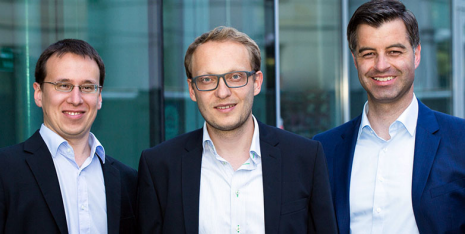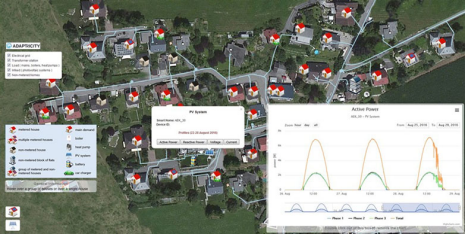The smart grid analysts

ETH spin-off Adaptricity has developed software that can be used to analyse the increasingly intelligent power grids. It will soon be put to the entrepreneurial test, with sales of software licences set to begin this autumn.
Andreas Ulbig and Stephan Koch must have had a sixth sense. When the two ETH doctoral students began tinkering with a software solution for intelligent power grids in 2010, they could scarcely have known that just a few years later, the Federal Council and the Swiss people would vote for a phase-out of nuclear power. Without this energy transition, the two scientists might never have turned their idea into a start-up. But that is precisely what they did, teaming up with business IT specialist Francesco Ferrucci to found Adaptricity at the start of 2014.
One of the biggest problems with the energy transition are the high costs; for example, electricity grids must be expanded in order to keep pace with the rising proportion of renewable energy, heat pumps and electric cars. As copper cable for power line construction is becoming increasingly expensive, the necessary investment runs into the billions. This is where Adaptricity comes in: the company's founders have developed software that helps power grid operators better understand and plan their networks. As a result, unnecessary investment can be avoided and in fact necessary grid investment can be made more cost-effective.
Distribution grid as a big black box
Ulbig (35) is chief operating officer of Adaptricity and – like CEO Koch – came from Germany to do his doctorate at ETH. He opens his laptop and shows us an example to illustrate how the simulation works. On the screen, we see a satellite map showing power lines to individual households. Ulbig can simulate what happens if a photovoltaic system is built in the district. With a click of the mouse, he drags one on to the map. The network voltages change immediately, but only by a minimal amount. Moreover, no more than 15 percent of the area's grid capacity is used, even in peak times. Ulbig's conclusion: "You could build this PV system easily without having to upgrade the power grid."
Ulbig is amazed at how little is still known about power grids. "The distribution grids are like a big black box," he says. This means that grid operators often learn of power outages only when those affected call the power companies to report a fault. In Swiss households, electricity meters are typically still read by power company employees. This could soon change, however, as the federal government is planning to invest in smart meters, which allow data to be retrieved in real time. Adaptricity can analyse the data supplied by these intelligent electricity meters and calculate the corresponding network load. Thus, the company brings light into the darkness of the black box, creating grid transparency.

In the midst of a growth spurt
Until recently, Adaptricity's company head office was a 25 m2 room in ETH's Power Systems Laboratory. It all began when Koch was hired by ETH as part of the Pioneer Fellowship programme after completing his thesis. After foundation of the company, Koch was joined by other staff members, many of them students or interns. Together, they worked on the software and took part in research and pilot projects in collaboration with ETH. At first, projects like these provided the small ETH spin-off with its initial funding, in addition to some consulting contracts for Swiss grid operators. In 2015, Adaptricity also received CHF 130,000 in start-up assistance from the Venture Kick funding initiative.
Since the start of 2017, however, Adaptricity has been on a growth path. In February, the cable manufacturer LEONI acquired a two-thirds stake, putting the company on a sound financial footing for now. As a result, the start-up moved from ETH to Hohlstrasse in Zurich's Kreis 4. Today, the company employs 22 staff members, some of them in Germany.
Success depends on licence sales
However, the biggest change is yet to come. Until now, Adaptricity has derived its turnover primarily from consulting contracts with grid operators in Switzerland and Germany. Last year, this work alone earned the company a six-figure sum. However, the company's future success will depend on a different, scalable model: the sale of licences for its SmartGrid software platform.
Adaptricity's IT staff are currently putting the final touches to the product, with sales expected to begin this autumn. The success of this line of business will determine whether Adaptricity meets its objectives: the company's founders hope to break even in the 2019 financial year. At present, the company's success comes first – so much so that co-founder Ulbig, who is also a part-time lecturer at ETH, recently refused an offer of a full professorship at a German university.
It's easy to draw up a list of Adaptricity's potential customers, as grid operators are the only suitable candidates. In Switzerland, they are all publicly owned. However, the company is also looking abroad. Luckily for the company, the energy transition is a political trend not only in Switzerland but also in other countries, such as Germany. The starting position for Adaptricity is therefore the same as before its foundation: ultimately, politics will decide how much money is put into renewable energy and thus into intelligent power grids. The more politicians push the issue, the better for the smart grid analysts from Zurich.
Provided by ETH Zurich





















